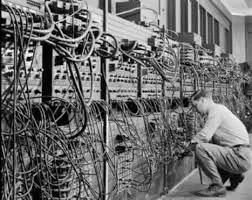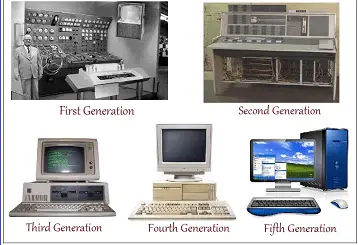Computer Generations: Brief Overview Examples, Applications, and Comparative Insights
The history of computing has been an extraordinary path of innovation and transformation. As computers advanced through various generations, they grew exponentially in speed, became more compact, enhanced efficiency, and gained extraordinary power. Each new generation introduced breakthroughs in hardware, software, and functionalities that reshaped how we live, work, and communicate. This article will take you through the different computer generations, their defining features, examples, and applications, along with a comparative analysis of their advancements.
What Defines a Computer Generation?
The term “computer generations” reflects the major technological advancements that revolutionized computer systems over time. Each generation is distinguished by the technological leap that led to vast improvements in processing speed, storage capabilities, and overall performance.
There are five distinct generations of computers, each marking significant technological progress:
- First Generation Computers (1940-1956): Vacuum Tubes
- Second Generation Computers (1956-1963): Transistors
- Third Generation Computers (1964-1971): Integrated Circuits
- Fourth Generation Computers (1971-Present): Microprocessors
- Fifth Generation Computers (Present and Beyond): Artificial Intelligence
Let’s delve deeper into these generations, exploring their key features and real-world applications.
First Generation Computers (1940-1956): Vacuum Tubes
The earliest computers also called First generation computers relied on vacuum tubes as their primary electronic component for both processing and memory functions. These computers were massive, often occupying entire rooms, and consumed immense amount of power. They frequently got overheated, leading to malfunctions due to the high heat output of vacuum tubes.

Key Components of First Generation Computers are:
- Components: Vacuum tubes
- Size: Enormous and cumbersome
- Processing Speed: Extremely slow (measured in milliseconds)
- Memory: Magnetic drums
- Input/Output: Punch cards, paper tape
Example:
- ENIAC (Electronic Numerical Integrator and Computer): Among the first general-purpose electronic computers, developed for military applications.
Usage:
- Military: Calculations for artillery firing tables.
- Scientific Research: Solving complex mathematical problems.
Limitations:
- Size & Power: Required vast space and consumed excessive power.
- Heat Issues: Prone to overheating, leading to frequent system failures.
Second Generation Computers (1956-1963): Transistors
The introduction of transistors marked a significant leap forward in computing. These devices replaced vacuum tubes, making computers smaller, faster, and more reliable. Transistors were more energy-efficient and emitted less heat and there were much different in there sizes as compared to vacuum tubes
Key Components:
- Components: Transistors
- Size: Much smaller than the first generation
- Processing Speed: Faster (measured in microseconds)
- Memory: Magnetic core memory
- Input/Output: Punch cards, magnetic tape
Example:
- IBM 7090: A successful second-generation computer, widely used in aerospace and defense.
Usage:
- Business: Payroll processing and inventory management.
- Scientific Computing: Weather forecasting and atomic energy computations.
- Military: Missile guidance and defense research.
Advantages:
- Increased Reliability: Transistors were more dependable than vacuum tubes.
- Cost and Size Reduction: Computers became affordable and more accessible for businesses.
Third Generation Computers (1964-1971): Integrated Circuits
The advent of integrated circuits allowed hundreds of transistors to be embedded onto a single chip, significantly reducing the size of computers while boosting their speed and functionality.
Key Components:
- Components: Integrated circuits (ICs)
- Size: Much smaller than previous generations
- Processing Speed: Measured in nanoseconds
- Memory: Magnetic core, later replaced by semiconductor memory
- Input/Output: Keyboards and monitors replaced punch cards
Example:
- IBM System/360: A popular third-generation computer, supporting various commercial and scientific applications.
Usage:
- Commercial: Data processing for large businesses and banking systems.
- Government: Census data processing and tax calculation.
- Research: Complex scientific simulations.
Advantages:
- Compact Size: IC technology made computers considerably smaller.
- Multitasking: Operating systems allowed multiple programs to run concurrently.
Fourth Generation Computers (1971-Present): Microprocessors
The fourth generation introduced microprocessors, single chips that contained an entire computer’s central processing unit (CPU). This led to the proliferation of personal computers (PCs), driving the widespread commercialization of computers for home and business use.
Key Components:
- Components: Microprocessors
- Size: Desktop and portable computers
- Processing Speed: Faster (nanoseconds to picoseconds)
- Memory: Semiconductor memory (RAM, ROM)
- Input/Output: Keyboards, mice, monitors, printers
Example:
- Intel 4004: The first commercially available microprocessor, which powered early personal computers.
Usage:
- Home Computing: Personal computers entered homes.
- Business: Office work, document processing, and accounting were revolutionized.
- Education: Computers became essential for research and teaching.
Advantages:
- Affordability: Microprocessors made computers accessible to the general public.
- Portability: Laptops and portable devices enabled mobile computing.
Fifth Generation Computers (Present and Beyond): Artificial Intelligence
The current generation is focused on artificial intelligence (AI), machine learning, and quantum computing, making systems smarter and more capable of handling large-scale data analysis with speed and precision.

Key Attributes:
- Components: Advanced processors, quantum chips, AI hardware
- Size: From cloud-based systems to compact devices
- Processing Speed: Significantly accelerated by quantum capabilities
- Memory: Cloud storage and large-scale data centers
- Input/Output: Voice recognition, natural language processing, advanced touch interfaces
Example:
- IBM Watson: An AI-driven system capable of analyzing vast datasets, used in fields like medical diagnostics and legal research.
Usage:
- Healthcare: AI supports medical diagnostics, drug discovery, and patient care.
- Finance: Algorithms that analyze markets, predict trends, and automate trading.
- Education: AI personalizes learning and improves access to information.
- Industry: Robotics and AI-powered automation enhance efficiency.
Advantages:
- Problem-Solving: AI systems tackle complex problems faster than humans.
- Machine Learning: Computers can learn from data and improve over time.
A Comparative Overview of Computer Generations
| Generation | Technology | Size | Speed | Memory | Input/Output | Examples |
| First Gen | Vacuum Tubes | Very Large | Milli seconds | Magnetic Drums | Punch Cards, Paper Tape | ENIAC, UNIVAC |
| Second Gen | Transistors | Large | Micro seconds | Magnetic Core | Punch Cards, Magnetic Tape | IBM 7090, UNIVAC II |
| Third Gen | Integrated Circuits | Smaller | Nano seconds | Magnetic Core | Keyboards, Monitors | IBM System/360, PDP-8 |
| Fourth Gen | Microprocessors | Desktop-size | Nano seconds-Pico seconds | RAM, ROM | Keyboards, Mice, Printers | Intel 4004, Apple II, IBM PC |
| Fifth Gen | AI & Quantum Chips | Varies | Extremely Fast | Cloud, AI Hardware | Voice, Natural Language | IBM Watson, Quantum Computers |
Frequently Asked Question
How many generations of computers are there?
There are five recognized generations of computers:
- First Generation: (1940-1956) Vacuum Tubes
- Second Generation: (1956-1963) Transistors
- Third Generation: (1964-1971) Integrated Circuits
- Fourth Generation: (1971-Present) Microprocessors
- Fifth Generation: (Present and Beyond) Artificial Intelligence (AI) and Quantum Computing
What were the key characteristics of first-generation computers?
First-generation computers used vacuum tubes for processing, were extremely large in size, consumed a lot of power, and were prone to overheating. They had very slow processing speeds and used magnetic drums for memory.
How did second-generation computers improve over the first generation?
The second generation saw the replacement of vacuum tubes with transistors, making computers smaller, faster, and more energy-efficient. This generation was also more reliable and less prone to overheating
What innovation defined the third generation of computers?
The third generation was marked by the use of integrated circuits (ICs), which allowed multiple transistors to be embedded on a single chip. This made computers much smaller, faster, and capable of multitasking.
What are microprocessors, and why are they important in the fourth generation?
Microprocessors are chips that contain the entire CPU of a computer. They were a key innovation of the fourth generation, enabling the development of personal computers (PCs) and leading to the mass commercialization of computing.
What are the defining characteristics of fifth-generation computers?
Fifth-generation computers focus on artificial intelligence (AI), machine learning, and quantum computing. These systems are incredibly fast and are designed to handle vast amounts of data with advanced capabilities like voice recognition and natural language processing.
Can you give an example of a computer from each generation?
- First Generation: ENIAC (Electronic Numerical Integrator and Computer)
- Second Generation: IBM 7090
- Third Generation: IBM System/360
- Fourth Generation: Intel 4004, Apple II
- Fifth Generation: IBM Watson (AI system)
How has computer size changed across generations?
The size of computers has drastically reduced with each generation:
- First-generation computers were enormous and occupied entire rooms.
- By the second and third generations, computers became smaller but still large.
- In the fourth generation, desktop and portable computers emerged.
- Fifth-generation computers vary in size but can include compact devices and cloud-based systems.
What are the applications/use of computers in the fifth generation?
Fifth-generation computers are used in fields such as healthcare (for medical diagnostics and drug discovery), finance (for market analysis and automated trading), education (for personalized learning), and industry (for robotics and automation).
How have input and output devices evolved through computer generations?
Early generations used punch cards and paper tape for input/output. By the third generation, keyboards and monitors became common. In the fourth generation, mice, printers, and graphical user interfaces were introduced. Fifth-generation systems incorporate voice recognition and natural language processing for input/output.
What are the major advantages of artificial intelligence in computing?
AI systems can solve complex problems much faster than humans, and they improve over time through machine learning. AI is particularly beneficial for data analysis, automation, and enhancing decision-making in fields like healthcare, finance, and education.
How does quantum computing fit into the fifth generation?
Quantum computing, part of the fifth generation, uses quantum bits (qubits) to perform calculations much faster than classical computers. It has the potential to revolutionize fields requiring immense computational power, such as cryptography, drug discovery, and complex simulations.
Conclusion
The progression of computer generations has fundamentally reshaped our world, evolving from massive vacuum tube machines to the sophisticated AI-powered systems of today. Each generation has propelled us forward with new technologies, transforming the size, speed, and capacity of computing. As we look ahead, the future of AI and quantum computing promises an exciting new chapter in this ever-evolving journey.
By appreciating the milestones of each computer generation, we gain a clearer perspective on the incredible advancements that have shaped the digital era and what lies ahead.
